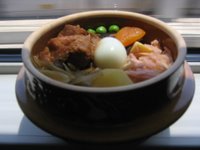Following up on last month's Food Destinations, I tried to come up with a similar list of places for Strasbourg that would offer the quintessential Alsatian experience.
First of all, if you are like me and obsessive about trying out every local specialty, there are three things you must eat when you go to Strasbourg. These are
choucroute,
baekoff and
coq au Reisling. Here are the places to go:
Lohkas 25 rue du Bain-aux-Plantes 67000 Strasbourg, 03-88-32-05-26
Located in the heart of the Petite France quarter, Lohkas offers typical Alsatian cuisine in a setting that couldn't get any more picturesque. Order the celebrated
choucroute garnie and you will get a heap of cooked fermented cabbage topped with several kinds of Alsatian sausages and various parts of salted pork, like slab of shoulder or gelatinous knuckle, served with pungent horseradish on the side. Excellent with local Alsatian beer.
Le Clou 3 rue du Chardon 67000 Strasbourg, 03-88-32-11-67
Located on a tiny pedestrian alley near the majestic pink-stoned cathedral, the cozy winstub distinguishes itself from others with its tasteful decor that mixes pretty Alsatian fabrics and blue-gray stoneware. The
baekoff, served in individual ceramic terrines, is simply outstanding. Try also the escargots, another local specialty-- my daughter had her first here when she was three and now smacks her lips every time she comes across a snail.
Klein 26 Boulevard d'Anvers 67000 Strasbourg
For some reason it's hard to find coq au Reisling on the menu in restaurants except the most touristic ones. Provided you have access to a kitchen, you're better off making it yourself. The first thing to do is to procure a good coq and for this I recommend Klein, one of the finest boucherie/traiteurs in town. Choose one with lean black feet and ask for it to be cut into eight pieces. Also pick up a bottle of Reisling, a pat of butter, cream and fresh
spaetzel (crinkly egg noodles) -- all available in the store. Next, head to the marche, two blocks away on Boulevard de la Marne, and buy a bunch of shallots, mushrooms, a lemon and some salad greens. You now have everything you need for an Alsatian feast.
Coq au Reisling (serves 4) adapted from
Haeberlin: les Recettes de l'Auberge de l'Ile-1 coq, about 2kg, cut into 8 pieces
-100g butter
-1 large onion, or several shallots, minced
-1 tablespoon of flour
-1/2 bottle of Reisling wine
-200g of champignons, cut in half
-250ml heavy cream
-1/2 lemon
1. In a deep casserole saute the pieces of meat in a bit of butter.
2. Sweat the minced onion or shallots in a bit of butter and add to the coq.
3. Sprinkle with flour, add the Reisling.
4. Cover and let simmer for 40 minutes.
4. Meanwhile, saute the mushrooms in a bit of butter.
5. Remove the pieces of meat from the casserole and cover with a foil to keep warm.
6. Reduce the liquid by half, then add the cream, mushrooms with its cooking liquid, lemon juice and any remaining butter.
7. Return the coq to the sauce and adjust seasoning.
*Serve with fresh spaetzels and a green salad.
Next, a short tram ride from centre ville takes you to the university quarter and our old apartment on rue Wimpheling. For five years I experienced the bliss of living a stone's throw away from an exceptional boulangerie and patisserie:
Jean-Claude Fritsch 13 rue Wimpheling 67000 Strasbourg
Downstairs from our apartment was a unpretentious Alsatian boulangerie where you could get warm
kugelof (distinctly shaped raisin-studded brioche with a crown of almonds), fresh
breh'zen (soft pretzel) and every weekday at noon, a
tarte flambee (super thin crust toppped with onion, lardon and creme fraiche) fresh out of the oven. Madame Fritsch would exchange gossip with each client, switching easily between French and Alsatian, and she would reach into a jar for a petit beurre every time she saw my daughter.
Jean-Claude Zeigler 23 Avenue de la Foret Noire 67000 Strasbourg
Down the street on the corner was Zeigler's, a chic patisserie with an attractive tea salon. Creations were displayed in the window case and reflected the passing seasons. Beginning with January, as soon as the national
galettne des rois fever died down, the carnival
beignets made their appearance. In lieu of traditional apple beignets Zeigler's version had elegant fruit-fillings of fresh fig, apricot or rasberry. Easter meant lamb-shaped sponge cakes dusted with powdered sugar. The appearance of meringue-topped
tarte a la rhubarbe heralded the arrival of spring. Summer months meant
tarte aux quetsch and
tarte aux mirabelles, purple and golden prunes typical of the region. Chestnut cream-based
torche aux marrons signaled the end of vacations. Autumn months meant cakes of newly harvested walnuts, lemon and chocolate. Then it would be time for the famed Christmas
bredele, an assortment of small butter or almond biscuits in heart and star shapes, spiced with cinnamon and anise.
Although it is Zeigler's calendar that we came to intimately know, most Strasbourgoise bakeries and pastry shops follow similar schedules. Be sure to sample whatever is in season when visiting. Bon apetit!
 One of the questions in the "Proust questionnaire" (extended version) asks: What is your favorite journey?
One of the questions in the "Proust questionnaire" (extended version) asks: What is your favorite journey?
